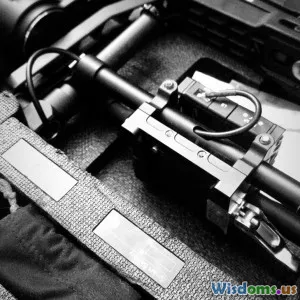
How to Maintain Your Personal Firearm for Longevity and Safety
18 min read Learn essential firearm care tips to ensure safety, reliability, and long-term performance of your personal weapon. (0 Reviews)
How to Maintain Your Personal Firearm for Longevity and Safety
Owning a firearm brings a profound sense of responsibility. Whether you use your firearm for personal protection, sport shooting, hunting, or as a collector, regular and proper maintenance is critical—not just to ensure its reliability, but to maximize its lifespan and maintain the safety of everyone around you. Let’s explore best practices, smart tips, and real-world examples you can adopt to care for your firearm like a pro.
Understanding Why Maintenance Matters

Failure to maintain your firearm isn’t a trivial oversight—it could be the difference between safe operation and a catastrophic malfunction. According to a 2023 National Shooting Sports Foundation (NSSF) study, nearly 40% of malfunctions reported at shooting ranges are attributed to improper cleaning and maintenance. Dirt, fouling, rust, and general wear all threaten the reliability of moving parts and can lead to jams, misfires, and even dangerous failures like barrel obstructions or accidental discharges.
Firearms, like any mechanical device, comprise metal, plastic, or wooden components that are exposed to the elements. Sweat, grime, unburnt powders, and oils all accumulate inside the barrel and action after use, making consistent maintenance an absolute essential. Besides functionality, proper upkeep maintains the resale value and historical accuracy for collectors.
Gather the Right Tools and Materials

Every maintenance ritual starts with the proper gear. Investing in a quality gun cleaning kit makes the task more convenient and effective. Here’s what you’ll need:
- Cleaning rods: Long, sturdy rods sized for your firearm’s barrel (rifle, pistol, shotgun, etc.).
- Bore brushes and mops: Attachments tailored to scrub or swab out residue and fouling.
- Patches and patch holder/jag: Absorbent patches that apply solvents and wipes inside the barrel.
- Solvents and degreasers: Break up carbon, copper, and lead fouling.
- Lubricants and oils: Preserve moving parts and prevent corrosion.
- Cleaning mat: Protects both your workspace and your firearm’s finish.
- Nylon and brass brushes: Use these to scrub slides, bolts, or hard-to-reach crevices without damaging metal surfaces.
- Microfiber cloths or rags: For wiping and applying oil—avoid old t-shirts that can shed fibers.
As an example, brands like Hoppe’s, M-Pro 7, and Breakthrough Clean Technologies offer complete kits for various firearm types. Customize your kit as you learn your needs—add chamber brushes, picks, and bore snakes for faster cleanups.
Pro Tip: Never substitute household cleaners for firearm chemicals—some can damage polymer or specialty coatings.
Establishing a Regular Cleaning Schedule

Just as you routinely service your car, set a regular cleaning interval for your firearm. The frequency should be tailored to your usage pattern and specific firearm:
- Every use: Clean after every live-fire session, especially after shooting corrosive ammo, in wet/humid conditions, or at dusty outdoor ranges.
- Monthly: If you’re not actively shooting, inspect and wipe down your firearm at least once a month.
- Before/after long-term storage: Deep clean and lubricate before storage; inspect or clean after retrieving from the safe.
A 2021 survey from Backfire.tv found that marksmen who clean their firearms after each use experience 30% fewer malfunctions versus those delaying regular cleanings. Hunters, in particular, should check for moisture that could foster rust after a day in the field.
Keep a maintenance log—record when you cleaned, inspected, and replaced parts. Apps like GunSafe or a simple notebook suffice and help predict when critical parts need replacement (recoil springs, firing pins, extractor claws, etc.).
Step-by-Step: Cleaning Pistols, Rifles, and Shotguns

Pistol
- Ensure the firearm is unloaded. Remove the magazine, rack the slide, and visually/physically inspect the chamber.
- Field strip according to manufacturer instructions. All major components—slide, barrel, frame, recoil spring—should be separated.
- Clean the barrel. Attach a patch holder or jag to your cleaning rod. Soak a patch with solvent and run it through the barrel from chamber to muzzle. Let it sit for 10-15 minutes to loosen fouling. Use a bronze brush to scrub, then run clean patches through until they come out only lightly stained.
- Clean the slide/firing pin channel. Use a nylon brush and light solvent. Be very conservative with oils—excess in the firing pin channel can gum things up.
- Lubricate. Apply a thin layer of gun oil at contact points—rails, barrel hood, locking lugs, and a dash on the slide.
- Reassemble and function check. Dry fire (if permitted), cycle the slide, and ensure everything operates smoothly.
Rifle & Shotgun
The steps are similar but emphasize the receiver, bolt/firing mechanism, and, for shotguns, the magazine tube and chokes. Always refer to your manual; AR-style rifles or break-action shotguns have unique procedures. Bore snakes can quickly clear smoothbores or longer barrels between deep cleanings.
Real-World Insight: According to the NRA Museums, a World War II M1 Garand stored with cosmoline and cleaned only once every two years still fired perfectly after 70 years—evidence that meticulous initial cleaning and proper lubricants can preserve firearms for generations.
Avoiding Common Maintenance Mistakes

Mistakes in maintenance are more common than you might imagine, and they often create new problems. Here are some of the top blunders and how to avoid them:
- Over-lubrication: Too much oil attracts dust and carbon, leading to sticky actions. Use just enough to make metal shine but not pool.
- Neglecting the magazine: Magazines accumulate grit and rust just like barrels. Disassemble (according to manufacturer guidance), clean, and wipe with a silicone-treated cloth.
- Using improper tools: Avoid steel brushes or screwdrivers that can mar finishes or scratch metal. Always use soft, firearm-rated brushes and non-marring punches.
- Forgetting about wood or polymer: Furniture needs care too—use proper oils for wood stocks; avoid harsh solvents that dry wood or degrade polymers.
- Failing to function check: After reassembly, conduct a full functionality check—trigger reset, mag release, slide/breach movement—to avoid surprises at the range.
A famous cautionary tale is that of the historic Sigma P226 used in the FBI: overapplication of lubricant in the firing pin channel led to light primer strikes and failures to fire during critical testing rounds. Modern firearm design corrects many legacy issues, but attention to detail prevents accidental disabling of your sidearm.
Inspecting Firearms for Wear and Potential Failures

Regular cleaning is also the perfect time to check for unusual wear, fatigue, or damaged components. Here’s what to look for with each cleaning:
- Cracks in critical parts: Inspect the frame, slide, and barrel lugs.
- Roll pins, screws, and clips: Ensure fasteners are tight and secure. Any that thread into metal should be checked with appropriate torque settings.
- Extractor and ejector: Look for chipping, cracks, or deformation.
- Springs: Any spring that has lost tension or shows rust should be replaced. Authorities recommend recoil springs for semi-autos be replaced every 3,000–5,000 rounds, depending on the model.
- Barrel and crown: Ensure no bulges, excessive pitting, or obstructions.
If you spot any critical wear, replace parts promptly—consult your manual or a certified gunsmith. Many modern pistols offer drop-in part replacements for common failures, making at-home service convenient for diligent owners.
Selecting and Storing Lubricants for Different Climates

Just as engine oil must suit your car’s climate, so must firearm lubricants cater to your environment.
- Cold environments: Select low-viscosity synthetic oils (like Slip2000 or BreakFree CLP) that don’t stiffen or seize operating parts below freezing.
- Hot, humid climates: Favor corrosion-inhibiting greases, and oil after every outdoor use. Light films of Ballistol or Eezox resist salt and moisture.
- Desert/dusty conditions: Less is more—minimize oils that attract abrasive grit; wipe down exteriors with light silicone cloths.
- Safe/long-term storage: Use specialty "storage" greases or VCI (volatile corrosion inhibitor) bags; avoid storing firearms in cases that trap moisture.
Expert Note: In 2022, the Civilian Marksmanship Program documented the effects of improper storage oil: one collector lost 15% of a vintage bolt-action rifle’s value due to rust pitting that occurred in only 18 months of humid basement storage. Always store firearms in a dry, temperature-controlled safe with desiccants.
Safe Handling During and After Maintenance

Every act of cleaning or handling must respect firearm safety rules:
- Keep the muzzle pointed in a safe direction. Even when you know it’s unloaded.
- Remove ammunition and store separately. Store all live ammo in another room or container while you clean.
- Double-check the chamber. Visually and physically inspect for any rounds—use a chamber flag when available.
- Store parts and tools securely. Small components can become hazardous if misplaced—use a tray or parts organizer.
- Complete function checks carefully. Dry fire only in a safe direction, and if possible, use a snap cap or dummy round.
According to the Centers for Disease Control and Prevention, nearly 35% of accidental firearm injuries occur at home, with a notable proportion linked to cleaning or handling mishaps. Making safety a routine, not an afterthought, is the mark of a truly responsible owner.
Going Beyond: When to Seek Professional Gunsmithing

Some maintenance goes past the reach of even a diligent hobbyist; for these cases, turn to a professional gunsmith.
- Trigger jobs and action tuning: Precision work beyond ordinary cleaning; improves function or feel but requires expertise.
- Re-barreling, headspacing, or chamber repairs.
- Structural work: Cracks in frames, lockup issues, or damaged optics mounts.
- Restoration of antiques/historic pieces. Specialized knowledge and period tools are required.
- Persistent functional issues: If malfunctions endure after routine maintenance, get an expert diagnostic.
Check your owner’s manual—many manufacturers recommend periodic factory service, often for free during warranty periods. An example: Glock’s Armorers Course offers certified maintenance for duty handguns every 12,000 rounds.
Tip: Keep receipts and a record of professional service for insurance purposes and future resale.
Leveraging Maintenance for Firearm Longevity

Firearms are among the most durable mechanical devices—with many lasting for generations if properly maintained. The current oldest functional firearm is the Heilongjiang hand cannon, over 700 years old, evidencing the resilience of good design and discipline in upkeep. Using modern gun-care products, today’s owners can stretch the life of their sidearms even further.
Realistically, achieving heirloom status for your firearm means:
- Storing permanently in dry, low-humidity environments, preferably in safes or cases with desiccants.
- Maintaining exterior finishes: Periodically apply waxes or protectants, especially on blued steel or case-colored parts.
- Replacing wear components as preventative maintenance. Never let recoil, extractor, or magazine springs go past life expectancy.
- Documenting maintenance and ownership for future generations. A simple log of service, accidents, part replacements, and professional work exponentially raises future value for both collectors and families.
One striking example is the case of Winchester Model 1894 rifles passed down for over a century, their walnut stocks kept rich and their barrels spotless. Most were preserved not by secrets, but by ordinary owners who performed consistent, documented care.
Empowering Responsible Firearm Ownership

Maintaining your firearm isn’t just mechanical—it’s a core expression of responsible citizenship. When you routinely clean, inspect, and safely store your guns, you not only prevent accidents but also model stewardship for family, friends, and your shooting community.
Share your knowledge with new enthusiasts and younger shooters. Walk them through a maintenance session. Openly discuss why care is non-negotiable, and use every moment as an opportunity to pass down respect and tradition.
In summary:
- Meticulous maintenance means safety and longevity.
- Proper tools, chemicals, and expert guidance make the job easier.
- A documented routine and knowledge of when to call a professional secures your investment for years to come.
Treat every maintenance task with gravity, diligence, and respect—it’s the best insurance for both performance today and legacy tomorrow.
Rate the Post
User Reviews
Popular Posts
















